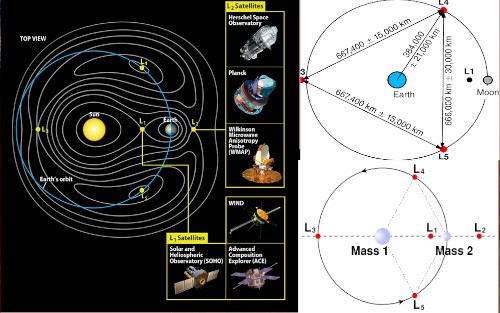A Lagrange point is a location in space where the combined gravitational forces of two large bodies, equal the centrifugal force felt by a much smaller third body. The interaction of the forces creates a point of equilibrium where a spacecraft may be "parked" to make observations.
To make it more simpler, Lagrange points are five special points where a small mass (space- crafts or telescopes) can orbit in a constant pattern with two larger masses (like sun and earth or moon and earth). The Lagrange Points are positions where the gravitational pull of two large masses precisely equals the centripetal force required for a small object to move with them.
Actually this is a mathematical problem, known as the "General Three-Body Problem" which is written on award winning paper in 1772 by mathematician, Joseph-Louis Lagrange.
L1
If we take a real life example of such system of SUN-EARTH system, L1, lies between Earth and the sun at about 1 million miles from Earth. L1 gets an uninterrupted view of the sun, and is currently occupied by the Solar and Heliospheric Observatory (SOHO) and the Deep Space Climate Observatory.
L2
L2 also lies a million miles from Earth, but in the opposite direction of the sun. At this point, with the Earth, moon and sun behind it, a spacecraft can get a clear view of deep space. NASA's Wilkinson Microwave Anisotropy Probe (WMAP) is currently at this spot measuring the cosmic background radiation left over from the Big Bang. And future place of James Webb Space Telescope .
L3
L3 lies behind the Sun, opposite Earth, just beyond our planet’s orbit. Objects in L3 cannot be seen from Earth. It offers the potential to observe the far side of the Sun. A spacecraft L3 (applies for all unstable points) is ‘meta-stable’, like a ball sitting on top of a hill. A little push or bump and it starts moving away, so a spacecraft must use frequent rocket firings to stay in so-called 'halo orbits' around the Lagrangian point.
As I mentation before, L1 and L2 points are unstable on a time scale of approximately 23 days, which requires satellites orbiting these positions to undergo regular course and attitude corrections.

L4 & L5
As seen from the Sun, the L4 and L5 points lie at 60 degrees ahead of and behind Earth, close to its orbit. Unlike the other Lagrange points, L4 and L5 are resistant to gravitational influence of other celestial bodies. Because of this stability, objects such as dust and asteroids tend to accumulate in these regions. At L4 or L5, a spacecraft is truly stable, like a ball in a large bowl. When gently pulled out of place, it orbits the Lagrange point without drifting away. Objects found orbiting at the L4 and L5 points are often called Trojans
Benefits of Lagrange Points
- Although it takes little adjustment to stabilize orbit but L1, L2, L3 are the most favorite and accurate spot for resting or parking a telescope.
- Far from the interfering heat and light of the sun, an asteroid-hunting spacecraft at a Lagrange point would be more sensitive to the tiny infrared signals from asteroids. It could point over a wide range of directions.
- L1 and L2 also “allow you to have enormous bandwidth” because over conventional Ka-band radio, the communication speeds are very high.
Discoveries made by observing Lagrange Points
Earth spinning Video
In 2016, NASA released a video of the Earth spinning through an entire year. The time-lapse was based on 3,000 pictures taken every two hours by the EPIC camera on the Deep Space Climate Observatory (DSCOVR) satellite, which was at L1.
OSIRIS-REX mission looking for NearEarth Asteroids
In February 2017, the OSIRIS-REX mission — then on its way to asteroid Bennu — spent about 10 days looking for additional Trojan asteroids in Lagrange points near Earth.
Mars' nine Trojan asteroids
A 2017 study suggests that Trojan asteroids near Mars are from the planet, and not captured asteroids from other regions in space. The smoking gun is that at least three of Mars' nine Trojan asteroids are high in olivine. This mineral is rare in asteroids, but common on larger bodies (including Mars, which has it in impact basins).

Topics like Lagrange Points are one of the easiest to understand and most important in field of observational astronomy, but sometimes because of the name people find it difficult to understand it. Contact me by email or on Instagram if you have any Questions regarding this topic.